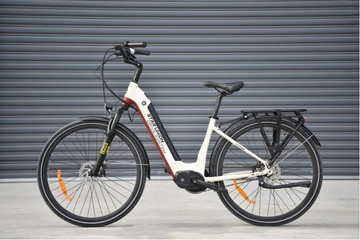Hydraulic Disc Brakes: Understanding the Brake Technology, Materials, and Craftsmanship
by RitterRuo on Feb 16, 2025

Hydraulic disc brakes are known for their powerful braking force, precise control, and reliable performance, making them one of the most popular braking systems in electric bikes and mountain bikes. In addition to their outstanding braking effects, the materials and craftsmanship behind hydraulic disc brakes are also key factors in their performance. This article will delve into the working principles, material selection, manufacturing processes, and maintenance of hydraulic disc brakes to help you gain a deeper understanding of this advanced technology.
What is a Hydraulic Disc Brake?
A hydraulic disc brake system is a braking technology that uses hydraulic fluid to transmit braking force. Unlike traditional mechanical disc brakes, hydraulic disc brakes use hydraulic fluid instead of steel cables to transmit braking signals, resulting in smoother, more precise, and more powerful braking performance. Hydraulic disc brakes are not only commonly used in regular bicycles but are also widely used in electric bikes, mountain bikes, and other vehicles that require strong braking power.

Working Principles of Hydraulic Disc Brakes
The working principle of hydraulic disc brakes is relatively simple but highly efficient. When the rider operates the brake lever, hydraulic fluid is transmitted through the lines to the brake calipers. The fluid pushes the pistons in the calipers, forcing the brake pads to contact the rotor, generating friction that slows the wheel and eventually stops it.
Brake Lever: The part operated by the rider to transmit pressure through hydraulic fluid.
Hydraulic Line: The hydraulic fluid travels through the lines to ensure the braking force reaches the brake calipers.
Brake Caliper: The fluid pushes the pistons inside the caliper, which forces the brake pads to contact the rotor and generate friction.
Brake Rotor: The metal disc that comes into contact with the brake pads, creating friction that slows or stops the wheel.
Material Selection for Hydraulic Disc Brakes
The performance of hydraulic disc brakes is influenced not only by their working principle but also by the materials used. Different materials affect the stability, durability, friction characteristics, and heat dissipation of the braking system. Common materials used in hydraulic disc brakes include brake rotors, brake pads, and calipers.
Rotor Materials:
Stainless Steel: Stainless steel rotors are widely used in hydraulic disc brakes due to their corrosion resistance, durability, and high strength. They can effectively withstand high temperatures generated during braking and maintain stable braking performance even in harsh weather conditions.
Carbon Fiber: Carbon fiber rotors are lightweight yet strong. They help reduce the overall weight of the bike while offering faster braking response and more precise control.
Alloy Materials: Alloy rotors are typically made from aluminum alloys or other metal alloys, which offer excellent heat resistance and heat dissipation, maintaining good braking performance even after prolonged use.
Brake Pad Materials:
Organic Pads: Organic brake pads are made from materials like rubber, resin, and other organic compounds. They are quieter and offer smoother braking, making them suitable for urban riding or moderate cycling environments. However, they have lower heat resistance and wear out faster under heavy use.
Sintered Pads: Made from metal alloys, sintered pads are durable and offer better performance in wet or high-temperature conditions. They are commonly used in mountain biking and electric biking for long-lasting braking power.
Caliper Materials: Brake calipers are generally made from aluminum alloys or titanium alloys, which are lightweight, corrosion-resistant, and durable. High-end calipers are often made from precision aluminum alloys, which are carefully processed to increase strength and reduce weight.
Manufacturing Processes of Hydraulic Disc Brakes
The manufacturing process of hydraulic disc brakes is complex and requires precise machining and quality control. Here are the key manufacturing processes for hydraulic disc brakes:
Precision Machining: The brake rotors and calipers are typically machined using CNC precision, ensuring that each part meets the design standards.
Heat Treatment and Surface Treatment: Brake rotors and pads undergo processes like anodizing and heat treatment to increase their wear resistance and corrosion resistance. High-quality heat treatment ensures stable performance at high temperatures.
Assembly and Sealing: During assembly, it is critical to ensure that all hydraulic lines are properly sealed, preventing oil leaks. Air bubbles must be thoroughly removed to avoid affecting braking performance.
Maintenance of Hydraulic Disc Brakes
While hydraulic disc brakes require less maintenance, regular checks and care are essential to ensure long-term performance. Here are some common maintenance tips:
Check Hydraulic Fluid: Regularly check the hydraulic system for oil levels and quality, and ensure that no air has entered the system




